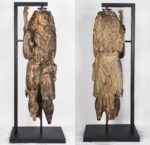 A 17th century wood statue of Samson, last judge of the Israelites, single-handed slayer of the entire Philistine army armed only with the jawbone of an ass, has been restored to its former strength. It wasn’t a stealth haircut from a temptress that enfeebled him this time, but years of exposure to the less-than-dulcet elements in Norwich covered up with thick layers of paint.
A 17th century wood statue of Samson, last judge of the Israelites, single-handed slayer of the entire Philistine army armed only with the jawbone of an ass, has been restored to its former strength. It wasn’t a stealth haircut from a temptress that enfeebled him this time, but years of exposure to the less-than-dulcet elements in Norwich covered up with thick layers of paint.
The statue of Samson and a matching figure of Hercules were commissioned in 1657 by Christopher Jay, the mayor of Norwich, as atlantids (carved columns) to flank the entrance of his new home facing Norwich Cathedral in the city’s historic center of Tombland. (Jay had the house built in 1656 incorporating a 15th century home on the site that had belonged to Sir John Fastolf, the inspiration for Shakespeare’s Falstaff.) So iconic did the two statues become that despite the mansion’s many illustrious owners over the years, it became known as the Samson and Hercules House.
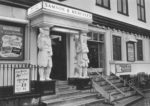 Christopher Jay enjoyed his fine guardsmen for twenty years. After his death in 1677, the house lived many lives. It was used as a private home, a surgery, a wool-combing concern, among other functions. In the 20th century, it was a YWCA for a spate before turning into a dance hall in the 1930s, which is what it would remain in various iterations of the concept until 2003. Today it is a Mexican restaurant franchise.
Christopher Jay enjoyed his fine guardsmen for twenty years. After his death in 1677, the house lived many lives. It was used as a private home, a surgery, a wool-combing concern, among other functions. In the 20th century, it was a YWCA for a spate before turning into a dance hall in the 1930s, which is what it would remain in various iterations of the concept until 2003. Today it is a Mexican restaurant franchise.
After Samson’s right arm, the one holding the jawbone of the ass, fell off 1992, residents rallied to the heroes’ defense and in 1993 Samson and Hercules were replaced with fiberglass replicas and the originals removed to the care of Norfolk Museums. That’s when researchers discovered that while the old Hercules was also a replica — a late 19th century replacement for the decayed original — Samson was the original 17th century piece. X-rays showed that under the thick layers of white lead paint were intricately carved details long obscured.
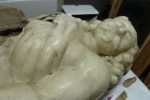 He was in such fragile condition — dismembered arm, literally rotten at the core — that it was not possible to put him on display, so Samson would remain in storage for another 20 years. After much negotiation and back-and-forth, Norfolk Museum Services officially acquired the statues in the late 1990s, but the ambitious project of restoring Samson to his 17th century glory would have longer to wait. The lead paint made him heavy and as long as he was coated in it, assessing the true extent of the rot would be difficult. You can’t just strip off lead paint, however, as it is a hazardous material, and the need to preserve any original features and traces of original color required extreme caution.
He was in such fragile condition — dismembered arm, literally rotten at the core — that it was not possible to put him on display, so Samson would remain in storage for another 20 years. After much negotiation and back-and-forth, Norfolk Museum Services officially acquired the statues in the late 1990s, but the ambitious project of restoring Samson to his 17th century glory would have longer to wait. The lead paint made him heavy and as long as he was coated in it, assessing the true extent of the rot would be difficult. You can’t just strip off lead paint, however, as it is a hazardous material, and the need to preserve any original features and traces of original color required extreme caution.
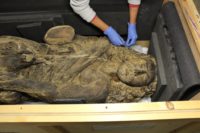 In 2014, the Norfolk Museums Service finally got the funding for essential conservation of the Samson statue. It engaged restorers Plowden & Smith to take on the dangerous and daunting task of removing the gross, bulbous cocoon of lead paint and enamel that had made the Biblical hero look like an amorphously lumpy Michelin Man. He was moved to Plowden & Smith’s conservation studio in London and experts embarked on the difficult job.
In 2014, the Norfolk Museums Service finally got the funding for essential conservation of the Samson statue. It engaged restorers Plowden & Smith to take on the dangerous and daunting task of removing the gross, bulbous cocoon of lead paint and enamel that had made the Biblical hero look like an amorphously lumpy Michelin Man. He was moved to Plowden & Smith’s conservation studio in London and experts embarked on the difficult job.
Conservators discovered a sizeable gap between the outer core and the inner, which they presumed had been caused by the figure drying out over time indoors. There was now a gap wide enough to fit a pencil into at some points, making it possible to remove much of the paint in fairly large pieces without using toxic and messy paint strippers. This was done rather like removing a plaster cast from a broken leg, by cutting carefully in the right places, in this instance with a hammer and a sharp chisel rather than an electric saw. Latterly, a scalpel was used for the finer work.
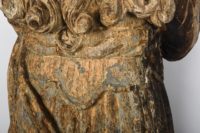 After four years of painstaking efforts by decorative arts and wood conservators, Samson’s features, carved from a single piece of oak, were seen once more: the long curls spilling down his back, his ripped, veiny forearms, the fine hairs of his moustache and beard, the bushy-tailed fox carried in his left arm, a grotesque-like head serving as the clasp on his robe, even traces of early gilding and colored paint. The crumbling, spongey areas of the wood were injected with a liquid consolidant and areas of loss filled with cellulose fiber to make him structurally sound again.
After four years of painstaking efforts by decorative arts and wood conservators, Samson’s features, carved from a single piece of oak, were seen once more: the long curls spilling down his back, his ripped, veiny forearms, the fine hairs of his moustache and beard, the bushy-tailed fox carried in his left arm, a grotesque-like head serving as the clasp on his robe, even traces of early gilding and colored paint. The crumbling, spongey areas of the wood were injected with a liquid consolidant and areas of loss filled with cellulose fiber to make him structurally sound again.
 In February of 2018, the museum launched a crowdfunding campaign with a target of £15,000 for a new custom-built, environmentally controlled display case that would allow Samson to stand guard again, secure and stable inside the museum’s first gallery. The humidity and light controls of the new case would allow curators to keep the wood from expanding and contracting and highlight his fine features for visitors. A rod inserted through the core of his body would make it possible for him to stand, even though his feet have rotted away. The target was achieved before the deadline.
In February of 2018, the museum launched a crowdfunding campaign with a target of £15,000 for a new custom-built, environmentally controlled display case that would allow Samson to stand guard again, secure and stable inside the museum’s first gallery. The humidity and light controls of the new case would allow curators to keep the wood from expanding and contracting and highlight his fine features for visitors. A rod inserted through the core of his body would make it possible for him to stand, even though his feet have rotted away. The target was achieved before the deadline.
The restored Samson was officially unveiled to the public in his new display case at the Bridewell Alley Museum of Norwich on April 3rd of this year.
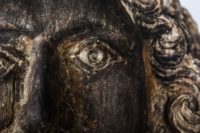
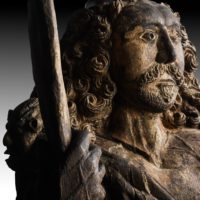
The New Shorter OED (which isn’t all that new, and certainly isn’t all that short) doesn’t include “atlantid,” but suggests “telamon” as “a male figure used as a pillar to support an entablature or other structure,” as opposed to the more familiar caryatid, a female figure.
It is amazing, how much paint was on it. They look like two different objects. I am so glad they found value in restoring it.
Friends,
It says in Bible that Samson killed 10,000 Philistines with the jawbone of an ass. So what? Some politicians have done worse using the same weapon.
Yours Aye,
Mungo Napier, Laird of Mallard Lodge
Wait! – Just for the record: Did he slay 1000 with that jawbone or 10000 with ten jawbones, and what damage would he have inflicted with a complete ass?
Earlier, the Lord had traded those ‘Israelites’ in -i.e. for forty years each- to either the Egyptians the Philistines and the Babylonians?
——————
Judges 15:15-17
——————
15 He found a new jawbone of an ass, and put forth his hand, and took it, and smote a thousand men therewith.
16 Samson said: With the jawbone of an ass, heaps upon heaps, With the jawbone of an ass have I smitten a thousand men.
17 As he fell silent, he cast away the jawbone out of his hand; and that place was called Ramath-Lehi [“The hill of the jawbone”].
——————
Apparently, “Ramath-Lehi” was the site of an Philistine encampment. However, as of today, Ramla lies along the route of the Via Maris, connecting old Cairo (Fustat) with Damascus, at its intersection with the road connecting the port of Jaffa with Jerusalem.
As it seems, in recent years. “ruins of a city site” were uncovered on the southern outskirts of Ramla: Notably, there might be heaps of Philistines, Asses and Jaws!
So, there was an ass making new jawbones? How many jawbones could an ass turn out per year?
Friends,
I freely admit to not being a Bible scholar. The last time I read Judges was in college almost 50 year ago.
My memory of the total comes from a song by Peter Paul and Mary, IIRC “If I Had My Way”, which I remember this way (also after some 50 years):
“. . . One day ol’ Samson, he was-a walkin’ alone
And he looked down on the ground and saw an old jaw bone.
Well he hefted up that jaw bone, swung it over his head,
and when got to movin’ ten thousand was dead.”
Yours Aye,
Mungo Napier, Laird of Mallard Lodge